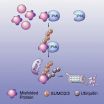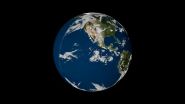(Press-News.org) WEST LAFAYETTE, Ind. - Global malnutrition could fall 84 percent by the year 2050 as incomes in developing countries grow - but only if agricultural productivity continues to improve and climate change does not severely damage agriculture, Purdue University researchers say.
"The prevalence and severity of global malnutrition could drop significantly by 2050, particularly in the poorest regions of the world," said Thomas Hertel, Distinguished Professor of Agricultural Economics. "But if productivity does not grow, global malnutrition will worsen even if incomes increase. Climate change also adds a good deal of uncertainty to these projections."
Hertel and doctoral student Uris Baldos developed a combination of economic models - one that captures the main drivers of crop supply and demand and another that assesses food security based on caloric consumption - to predict how global food security from 2006 to 2050 could be affected by changes in population, income, bioenergy, agricultural productivity and climate.
According to the models, income growth coupled with projected increases in agricultural productivity could raise more than half a billion people out of extreme hunger by mid-century.
Income is also set to eclipse population as the dominant driver of food security, a "historical first," said Baldos.
"We expect that the population driver will diminish relative to per capita income in the coming decades, especially in the developing world," he said.
Growth in income will allow people to increase the amount of food they consume and "upgrade" their diets by adding more meat and processed foods to staples such as crops and starches. The shift toward a diet higher in calories and richer in protein could lift many in hunger-stricken regions such as sub-Saharan Africa, South Asia, China and Mongolia above the malnutrition line.
Globally, the volume of food consumed per capita could increase by about 31 percent. In developing regions with strong growth in income and population, consumption could rise by about 56 to 75 percent.
But these projections depend heavily on corresponding increases in agricultural productivity, Hertel said. Productivity is a measure of crop yields relative to the inputs used in producing them such as land, labor and fertilizers. Increased global productivity improved the availability of food over the last 50 years, but this trend must continue between now and 2050 to buttress food security.
"There is a clear link between productivity growth in agriculture and the number of malnourished people," Hertel said. "Boosting productivity tends to lower food prices, and declines in the cost of food in turn can allow for better nutrition. Income growth alone will not be enough to solve the malnutrition problem."
Historically, agricultural productivity has been driven by investments in agricultural research and development. The researchers said improvements in food security depend on increasing research spending, especially over the next two decades.
"The decisions we make now about funding for agricultural research will have implications for a number of malnourished people in 2050," Hertel said. "If agricultural productivity stagnates, there will be far more malnourished people in the future, particularly in regions where chronic hunger is already present."
The researchers also cautioned that the impacts of a changing climate on crop yields remain uncertain.
Rising temperatures could extend the growing season in northern latitudes, and an increase in carbon dioxide in the atmosphere could benefit some crops by improving water efficiency. But climate change is complicated, Hertel said.
"Up to 2050, there could be some pluses for agriculture," he said. "But in the longer run, adverse temperatures will likely become overwhelming, and rising carbon dioxide concentrations won't help after a certain point. Eventually, you drop off a cliff."
The models show that climate change is a less influential driver of global food security than income, population and productivity - but it could still pose a significant risk to the nutrition levels of people living in the world's poorest regions, Baldos said.
"People living in the most hunger-stricken areas will be the most vulnerable to climate change."
INFORMATION:
The paper was published in the Australian Journal of Agricultural and Resource Economics.
Funding for the research was provided by the U.S. Department of Energy. END
Drop in global malnutrition depends on ag productivity, climate change
2014-05-29
ELSE PRESS RELEASES FROM THIS DATE:
Penn study shows how misfolded proteins are selected for disposal
2014-05-29
PHILADELPHIA – It's almost axiomatic that misfolded proteins compromise how cells normally function and cause debilitating human disease, but how these proteins are detected and degraded within the body is not well understood. Neurodegenerative diseases – including Alzheimer's disease, Parkinson's disease, amyotrophic lateral sclerosis (Lou Gehrig's disease), Huntington's disease, and spinocerebellar ataxias – exact a devastating toll on aging populations throughout the world.
"Yet, there is virtually no cure for any of these diseases, and clinical trials have yielded ...
Tropical Storm Amanda gets bisected and animated by NASA's CloudSat
2014-05-29
VIDEO:
This animation shows how Cloudsat was able to get the image shown.
Click here for more information.
Tropical Storm Amanda continues to weaken in the eastern Pacific from dry air and wind shear. NASA's CloudSat satellite captured a view of the storm from the side revealing heavy precipitation when the storm was the most powerful May Eastern Pacific on record.
NASA's CloudSat satellite flew over Hurricane Amanda in the east Pacific on May 25, 2014 at 2100 UTC (5 p.m. EDT) ...
An ecological risk research agenda for synthetic biology
2014-05-29
Washington — Environmental scientists and synthetic biologists have for the first time developed a set of key research areas to study the potential ecological impacts of synthetic biology, a field that could push beyond incremental changes to create organisms that transcend common evolutionary pathways.
The Synthetic Biology Project at the Wilson Center and the Program on Emerging Technologies at the Massachusetts Institute of Technology convened the interdisciplinary group of scientists and are releasing the report, Creating a Research Agenda for the Ecological Implications ...
Engineering a better way to rebuild bone inside the body
2014-05-29
Traumatic bone injuries such as blast wounds are often so severe that the body can't effectively repair the damage on its own. To aid the recovery, clinicians inject patients with proteins called growth factors. The treatment is costly, requiring large amounts of expensive growth factors. The growth factors also disperse, creating unwanted bone formation in the area around the injury.
A new technology under development at the Georgia Institute of Technology could one day provide more efficient delivery of the bone regenerating growth factors with greater accuracy and ...
Improved identification of war wound infections promises more successful treatment
2014-05-29
War wounds that heal successfully frequently contain different microbial species from those that heal poorly, according to a paper published ahead of print in the Journal of Clinical Microbiology. These and other findings have important implications for improving wound healing, says first author Nicholas Be of Lawrence Livermore National Laboratory, Livermore, California.
The problem the researchers were addressing is that culture-based identification, which has been used to assay war wound infections, misses the many species that are difficult or impossible to culture. ...
Huge tooth fossil shows marine predator had plenty to chew on
2014-05-29
A fossilised tooth belonging to a fearsome marine predator has been recorded as the largest of its kind found in the UK, following its recent discovery.
A team of palaeontologists have verified the tooth, which was found near Chesil Beach in Dorset, as belonging to a prehistoric relative of modern crocodiles known as Dakosaurus maximus.
The tooth, which has a broken tip, is approximately 5.5 cm long.
Researchers and curators from University of Edinburgh and the Natural History Museum in London identified the item after it was bought at an online auction by a fossil ...
Amber discovery indicates Lyme disease is older than human race
2014-05-29
CORVALLIS, Ore. – Lyme disease is a stealthy, often misdiagnosed disease that was only recognized about 40 years ago, but new discoveries of ticks fossilized in amber show that the bacteria which cause it may have been lurking around for 15 million years – long before any humans walked on Earth.
The findings were made by researchers from Oregon State University, who studied 15-20 million-year-old amber from the Dominican Republic that offer the oldest fossil evidence ever found of Borrelia, a type of spirochete-like bacteria that to this day causes Lyme disease. They ...
Remember parathyroid hormone as well as vitamin D to assess vitamin's role in diabetes
2014-05-29
TORONTO -- Combined assessment of parathyroid hormone along with vitamin D may be needed to assess the impact of vitamin D status on sugar metabolism, according to Toronto researchers. Their study is published on-line in Diabetes on May 29 2014.
The new findings might explain why studies of vitamin D alone have been conflicting and why clinical trials of vitamin D supplementation to improve diabetes have been disappointing, says principal investigator Dr. Ravi Retnakaran. He is a clinician-scientist at the Lunenfeld-Tanenbaum Research Institute at Mount Sinai Hospital ...
Grape-enriched diet supports eye health
2014-05-29
FRESNO, CA – New research presented this week at the Association for Research in Vision and Ophthalmology conference in Orlando, Florida suggests that regular grape consumption may play a role in eye health by protecting the retina from deterioration. Specifically, a grape-enriched diet resulted in a protective effect on retinal structure and function.
The retina is the part of the eye that contains the cells that respond to light, known as photoreceptors. There are two types of photoreceptors: rods and cones. Retinal degenerative diseases affect over 5 million people ...
First-of-its-kind study: Swimmers gain an advantage when they recover with chocolate milk
2014-05-29
Grabbing chocolate milk after a hard swim could give swimmers a performance edge, according to new research presented at one of the nation's top sports medicine conferences – the American College of Sports Medicine's annual conference.1 In a sport where seconds and even tenths of a second can make a big difference and intense practice routines are the norm, Indiana University researchers found that when collegiate, trained swimmers recovered with chocolate milk after an exhaustive swim, they swam faster in time trials later that same day. On average, they shaved off 2.1 ...





